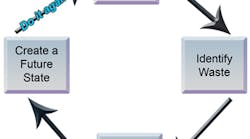Lean Manufacturing is a very effective method for making improvements within organizations. I first became aware of Lean when I joined Goodrich Corporation as a Manufacturing Engineer 13 years ago. I was trained and certified in Lean, and participated in numerous Lean events in our manufacturing operations. I quickly realized the advantages of Lean though Kaizen events with dedicated team members making improvements. Now, as a Continuous Improvement Specialist, I have learned that there is a simple 4-step approach to applying Lean.
Step No. 1. Document Reality
The first step involves “Documenting Reality.” Typically, this is done by using Lean tools such as Process Mapping, Standard Work, etc. This step should include going to “Gemba” to see what is really happening, if possible, which can reveal issues with the current state that may have been missed during the planning stages. Also, talk to the customer, or better yet do a “Voice of the Customer” overview to capture what they value.
When documenting reality, define the current process by observing the actual process if possible. If not, use a recent example to document reality. As you are constructing the “Current State,” use data to quantify the metrics associated with the current process such as cycle time, takt time, WIP, handoffs, wait time, etc. Using data is extremely important going forward in the process.
Step No. 2. Identify the Waste
Now that you have identified the Current State process it’s time to “Identify Waste.” The best way to identify waste is to use the traditional seven forms of waste — Inventory, Over-production, Transportation, Over-processing, Defects, Waiting, and Motion. In other words review the Current State documentation to find any of these opportunities for improvement. Highlight the problems and make these issues stand out so that it’s obvious where the problems are that must be addressed. Look for things like excessive waiting, walking, rework, sorting, searching, WIP, etc. Make a list of these issues — as many as possible — to be resolved in the next step.
Step No. 3. Remove the Waste
After you have identified the waste, the next step is to remove the waste. Do this by reviewing the list of issues and determining what countermeasures can be put in place to fix the problems you have identified. This is your opportunity to empower the team to use creative, out-of-the-box ideas to determine solutions to the problems.
Be selective when prioritizing the issues to be resolved: You may not have enough time and resources to fix all the problem(s). Identify the most critical ones and stay focused on these with the remaining time you have to implement solutions. Once they are identified, be aggressive in taking action to get things done. Don’t be afraid to assign team members to actions individually and as sub-teams, to divide and conquer.
Step No. 4. Create a Future State
Once the waste has been removed and problems have been resolved, it’s important to document the Future State. This documentation should show how the new process works using standard work, including process steps, cycle times, checklists, diagrams, charts, and any other information associated with the work being completed.
Plan to provide training and communication to the people affected by the new state. Communication is important anytime changes are made to the process. It’s a step that provides a chance for the team to discuss the new state and to answer any questions. This also may help their effort at buying-in to the new process.
Once the process is completed, plan to do it again. This is why we call it “continuous improvement”: it’s a journey. Remember Lean is not a four letter word, but a four step process. Keep it simple in implementing your Lean initiatives and learn by doing. It is amazing what a team of motivated employees can accomplish together.
Good luck.
The author is a Continuous Improvement Specialist with Goodrich Aircraft Wheels & Brakes, which designs, manufactures, tests and supplies aftermarket service for aircraft wheel and braking systems on over 200 programs. Contact him at [email protected].






